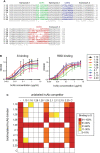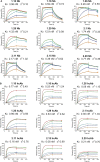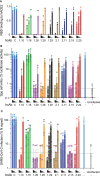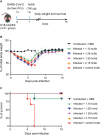Nanobodies Protecting From Lethal SARS-CoV-2 Infection Target Receptor Binding Epitopes Preserved in Virus Variants Other Than Omicron
- PMID: 35547740
- PMCID: PMC9082315
- DOI: 10.3389/fimmu.2022.863831
Nanobodies Protecting From Lethal SARS-CoV-2 Infection Target Receptor Binding Epitopes Preserved in Virus Variants Other Than Omicron
Abstract
The emergence of SARS-CoV-2 variants that escape from immune neutralization are challenging vaccines and antibodies developed to stop the COVID-19 pandemic. Thus, it is important to establish therapeutics directed toward multiple or specific SARS-CoV-2 variants. The envelope spike (S) glycoprotein of SARS-CoV-2 is the key target of neutralizing antibodies (Abs). We selected a panel of nine nanobodies (Nbs) from dromedary camels immunized with the receptor-binding domain (RBD) of the S, and engineered Nb fusions as humanized heavy chain Abs (hcAbs). Nbs and derived hcAbs bound with subnanomolar or picomolar affinities to the S and its RBD, and S-binding cross-competition clustered them in two different groups. Most of the hcAbs hindered RBD binding to its human ACE2 (hACE2) receptor, blocked cell entry of viruses pseudotyped with the S protein and neutralized SARS-CoV-2 infection in cell cultures. Four potent neutralizing hcAbs prevented the progression to lethal SARS-CoV-2 infection in hACE2-transgenic mice, demonstrating their therapeutic potential. Cryo-electron microscopy identified Nb binding epitopes in and out the receptor binding motif (RBM), and showed different ways to prevent virus binding to its cell entry receptor. The Nb binding modes were consistent with its recognition of SARS-CoV-2 RBD variants; mono and bispecific hcAbs efficiently bound all variants of concern except omicron, which emphasized the immune escape capacity of this latest variant.
Keywords: COVID-19; SARS-CoV-2 variants; coronavirus; nanobodies; neutralizing antibodies.
Copyright © 2022 Casasnovas, Margolles, Noriega, Guzmán, Arranz, Melero, Casanova, Corbera, Jiménez-de-Oya, Gastaminza, Garaigorta, Saiz, Martín-Acebes and Fernández.
Conflict of interest statement
JMC, YM, MN, PG, UG, JS, MM-A, JAC, and LF are co-inventors on patent applications covering the Nb and hcAb molecules described in this manuscript. The remaining authors declare that the research was conducted in the absence of any commercial or financial relationships that could be construed as a potential conflict of interest.
Figures







Similar articles
-
Integrating immune library probing with structure-based computational design to develop potent neutralizing nanobodies against emerging SARS-CoV-2 variants.MAbs. 2025 Dec;17(1):2499595. doi: 10.1080/19420862.2025.2499595. Epub 2025 May 6. MAbs. 2025. PMID: 40329514 Free PMC article.
-
A Glycosylated RBD Protein Induces Enhanced Neutralizing Antibodies against Omicron and Other Variants with Improved Protection against SARS-CoV-2 Infection.J Virol. 2022 Sep 14;96(17):e0011822. doi: 10.1128/jvi.00118-22. Epub 2022 Aug 16. J Virol. 2022. PMID: 35972290 Free PMC article.
-
A potent bispecific nanobody protects hACE2 mice against SARS-CoV-2 infection via intranasal administration.Cell Rep. 2021 Oct 19;37(3):109869. doi: 10.1016/j.celrep.2021.109869. Epub 2021 Oct 6. Cell Rep. 2021. PMID: 34644535 Free PMC article.
-
Bovine-derived antibodies and camelid-derived nanobodies as biotherapeutic weapons against SARS-CoV-2 and its variants: A review article.Int J Surg. 2022 Feb;98:106233. doi: 10.1016/j.ijsu.2022.106233. Epub 2022 Jan 19. Int J Surg. 2022. PMID: 35065260 Free PMC article. Review.
-
Surface charge changes in spike RBD mutations of SARS-CoV-2 and its variant strains alter the virus evasiveness via HSPGs: A review and mechanistic hypothesis.Front Public Health. 2022 Aug 24;10:952916. doi: 10.3389/fpubh.2022.952916. eCollection 2022. Front Public Health. 2022. PMID: 36091499 Free PMC article. Review.
Cited by
-
Identification of Significant Mutations in Spike Protein of SARS-CoV-2 Variants of Concern and the Discovery of Potent Inhibitors.Glob Health Epidemiol Genom. 2025 Apr 28;2025:5042190. doi: 10.1155/ghe3/5042190. eCollection 2025. Glob Health Epidemiol Genom. 2025. PMID: 40330793 Free PMC article.
-
Virus-Receptor Interactions and Receptor-Mediated Virus Entry into Host Cells.Subcell Biochem. 2024;105:533-566. doi: 10.1007/978-3-031-65187-8_15. Subcell Biochem. 2024. PMID: 39738957 Review.
-
Production of Plant Virus-Derived Hybrid Nanoparticles Decorated with Different Nanobodies.ACS Nano. 2024 Dec 17;18(50):33890-33906. doi: 10.1021/acsnano.4c07066. Epub 2024 Dec 2. ACS Nano. 2024. PMID: 39622501 Free PMC article.
-
SARS-CoV-2 prevalence in domestic and wildlife animals: A genomic and docking based structural comprehensive review.Heliyon. 2023 Aug 21;9(9):e19345. doi: 10.1016/j.heliyon.2023.e19345. eCollection 2023 Sep. Heliyon. 2023. PMID: 37662720 Free PMC article. Review.
-
Integrating immune library probing with structure-based computational design to develop potent neutralizing nanobodies against emerging SARS-CoV-2 variants.MAbs. 2025 Dec;17(1):2499595. doi: 10.1080/19420862.2025.2499595. Epub 2025 May 6. MAbs. 2025. PMID: 40329514 Free PMC article.
References
Publication types
MeSH terms
Substances
Supplementary concepts
LinkOut - more resources
Full Text Sources
Medical
Molecular Biology Databases
Research Materials
Miscellaneous

